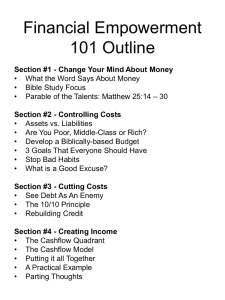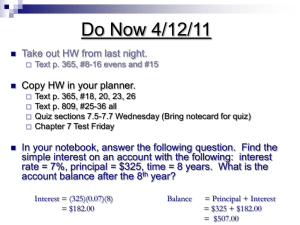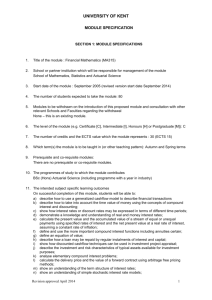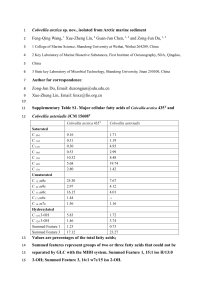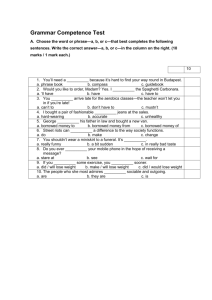Time Value of Money Concepts
advertisement
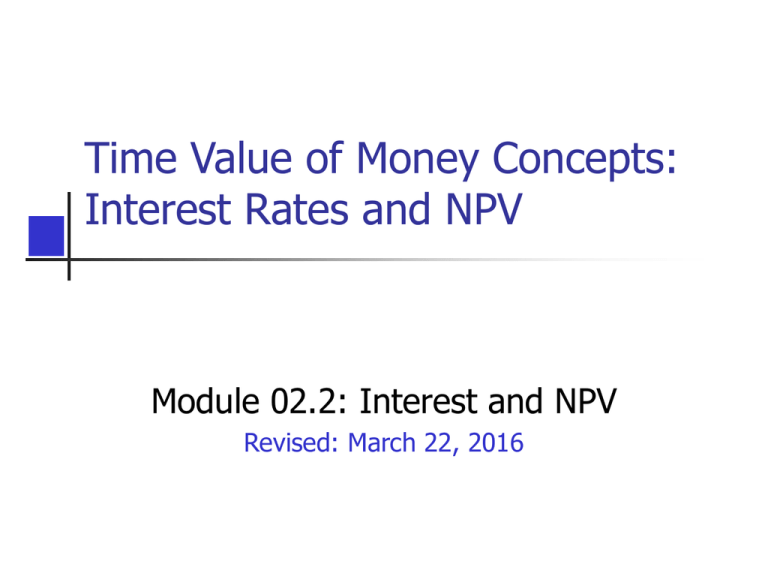
Time Value of Money Concepts: Interest Rates and NPV Module 02.2: Interest and NPV Revised: March 22, 2016 Purpose: Introduce Learners to the basic concepts of the “Time Value of Money.” Make a point about the importance of this topic to all engineers and to your personal financial well being. Since, the text book for this course assumes that everyone has had a course in engineering economy … … Learning Objective: Given a discrete future cashflow (a series of periodic cash payments and/or disbursements over time length N) compute the NPV (net present value) given the interest rate. Be able to draw a cashflow diagram of any given discrete cash stream. Why This Is Important All Projects involve a cash stream of some sort. It is usually a combination of both income and expenses. If the net is positive the project “made money”; otherwise, it “lost money.” One way to sort out project alternatives is through engineering economy. The General Concepts Money, besides being a measure of value, is a commodity, just like gold, oil, wheat, pork bellies ... … It is can be bought, sold, borrowed, loaned, saved, consumed, and stolen. When money is borrowed the “rent” is called interest. If you loan money you earn interest; If you borrow money you pay interest. Because the amount of interest is a function of time, the value of an amount of money varies as a function of time – this is a new concept to most of you. Concepts … There is simple interest and compound interest. Simple interest is as old as history itself. It is simply a certain % of the money loaned. Time may, or may not, be a factor. Compound interest is a relatively new invention (1700’s?) and is essentially, interest on interest. Other Essential Points You Need to Know… When interest rates are greater than zero, $$-amounts can only be summed at the same point in time. Usually, this means that all future $$ amounts are converted to a present value before they are summed. This is called “discounting” the cash flow. Almost every commercial project is evaluated and compared based upon some “discounted cashflow” – stocks, bonds, projects, real estate, … … Other Points … … When interest rates are zero $$-amounts can summed independent of time. Money is more valuable now than it is some time in the future -- “Get the money up front!” Unless specifically told otherwise, always assume compound interest. The Basic Formula PV = FV/(1+i%) n PV or P is present value FV or F is some amount in the future i%= the interest rate per period, years, months, weeks, n = the number of periods Example # 1 – Single Amount Question: What is the PV (the value now) of $10,000 that you expect to receive 2 years from now, if current interest rates are 10% compounded annually? Answer: PV=$10,000/1.12 = $8,264 PV=$8,264 Time = 0 (or now) FV=$10,000 Cash Flow Diagram 1 Years Time = 2 (or 2-years from now) RAT #3.1.1 – Take Up Work a P = F(1+%)^-n problem Work a F = P(1+%)^n problem As Individuals Example #2 - Multiple Amounts Discount given cash stream @ 10% EOY Amount 1/(1+%)^n PV 0 -10,000 1.0000 -10,000 1 2,000 0.9091 1,818 2 3,000 0.8264 2,479 3 4,000 0.7513 3,005 4 5,000 0.6830 3,415 10% 4,000 <- Sums -> 718 The Discount Factor is: (1+i)n = 1.1n RAT #3.1.2 Data Compute the Present Value, if i=0% (individuals) and i=20%. (team) EOY 0 1 2 3 Total Amount Disc. Factor -$10,000 $2,000 $3,000 $7,000 PV Memorize these Basic Assumptions to Avoid Exam Mistakes. The time the money is loaned or borrowed is broken into even time intervals (or, periods) – years, quarters, months, days. All cash-flow events occur at the ends of the time intervals and the interest rate per period is constant. Interest rates are generally expressed as nominal annual (per year =12%) but must be adjusted to fit the compounding period (per month =1%, per quarter =3%). A very common exam mistake. $1,000 now is equivalent to $8,916 12-years in the future at 20% interest. 20% $1,000 $1,200 $1,440 $1,728 $2,074 $2,488 $2,986 $3,583 $4,300 $5,160 $6,192 $7,430 $8,916 Brute Force $8,916 =F =P(1+%)n =$1,000(1.2)12 Present Money Grows Future Value of $1,000 Period 0 1 2 3 4 5 6 7 8 9 10 11 12 $10,000 $8,000 $6,000 $4,000 $2,000 $0 0 1 2 3 4 5 6 Years Maxwell’s 1-st Law: Get the Money Up-Front 7 8 9 10 11 12 $10,000 12-years in the future at 20% is equivalent to $1,122 now. 20% $10,000 $8,333 $6,944 $5,787 $4,823 $4,019 $3,349 $2,791 $2,326 $1,938 $1,615 $1,346 $1,122 Brute Force $1,122 =P =F(1+%)-n =$10,000(1.2)-12 Future Money Shrinks Present Value of $10,000 Period 12 11 10 9 8 7 6 5 4 3 2 1 0 $12,000 $10,000 $8,000 $6,000 $4,000 $2,000 $0 12 11 10 9 8 7 6 Years Maxwell’s Other Law: Take the Money and Run! 5 4 3 2 1 0 Summary One way to evaluate projects, stocks, bonds, etc. is by discounted cash flow. Amounts of money scattered at various points in time can only be summed at the same point in time – usually now. n The relationship: PV=FV/(1+%) is used to “move” money from one point in time to another
